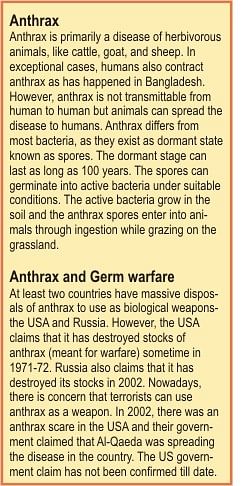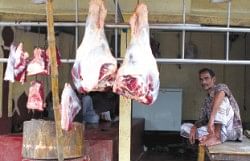An apparently deadly disease seems to be spreading panic across all sections of Bangladeshi society. According to figures published by the Institute of Epidemiology, Disease Control and Research (IEDCR), which operates under the Ministry of Health and Family Welfare, 589 people have contracted the disease till September 21, 2010. According to IEDCR, 12 districts out of 64 have been infected with found to have anthrax since the disease first broke out in Sirajganj, on August18, 2010.
The government is taking no chances. A countrywide red alert has been declared to prevent the biggest outbreak of anthrax till date. Veterinarians are checking all animals entering the capital and marks are being placed on the hide of the livestock to confirm that they are anthrax-free. Committees have been formed in all the 64 districts across the country to coordinate anthrax prevention and treatment efforts.
|
Victims of Anthrax infection. Photos: Star
|
The concerned ministries that are in the frontline against the anthrax war have claimed that the anthrax threat is under control. Fisheries and livestock minister Abdul Latif Biswas has assured that there are sufficient vaccines in the anthrax-affected areas and concerned authorities have already vaccinated all the livestock in the surrounding areas. He has also sait that civil surgeons, livestock department workers and NGO workers are working to prevent the anthrax outbreak. Health Ministry officials have also claimed that they are ready to combat the anthrax threat.
 For once, it seems that the government is not downplaying a threat. Despite the terror associated with anthrax nowadays, the disease is very much curable. However, there is very little awareness among the public because of some misinformation regarding the effects the disease can have on humans. Thus the unwarranted panic. On September 17, 2010 Bangladesh Paribesh Andolan (BAPA) organised a seminar titled "Spread of anthrax in Bangladesh: What is to be done". Speakers at the seminar included BAPA Convener Dr SK Roy, Prof Sania Tahmina, Agriculturist Abdur Razzaque Miah, Dr Mostaque Hossain, Dr Sabrina Flora and Dr Shakil Akhter, among others. They stressed on the need for creating awareness among the general populace but at the same time asserted that there is absolutely no reason to be panicked, as upazila level healthcare centres are equipped to treat infected patients.
For once, it seems that the government is not downplaying a threat. Despite the terror associated with anthrax nowadays, the disease is very much curable. However, there is very little awareness among the public because of some misinformation regarding the effects the disease can have on humans. Thus the unwarranted panic. On September 17, 2010 Bangladesh Paribesh Andolan (BAPA) organised a seminar titled "Spread of anthrax in Bangladesh: What is to be done". Speakers at the seminar included BAPA Convener Dr SK Roy, Prof Sania Tahmina, Agriculturist Abdur Razzaque Miah, Dr Mostaque Hossain, Dr Sabrina Flora and Dr Shakil Akhter, among others. They stressed on the need for creating awareness among the general populace but at the same time asserted that there is absolutely no reason to be panicked, as upazila level healthcare centres are equipped to treat infected patients.
There is no denying that many people are suffering. One of them is seven-year-old Hamza Miah. A black ulcer on his right eye gives him unbearable pain. According to his account, a neighbour sold his family a sick cow at half the price. Five days after consuming the meat, he contracted anthrax.
Ironically, the neighbour who had sold Hamza's family the meat has also contracted anthrax. So has the 45 other people who have come into bodily contact with the sick animal.
For poor villagers living on the margins of society, cattle and livestock are valuable commodities to own. For many ownership of a single cow is the only source of livelihood. Needless to say, the anthrax outbreak has sent ripples throughout the rural areas. “My only possession is a cow,” says Hasan Ali of Lalmonirhat. “In case I lose the cow to anthrax or any other disease, I will lose the only possession I have.” He says that under such circumstances the government should pay some sort of compensation, at least for the ultra poor villagers who have no alternative means of survival. Ali's opinion probably has some substance, as in many cases villagers have slaughtered, sold and consumed anthrax affected cattle and in the process have been infected with the disease.
|
The main risk factor for contracting cutaneous anthrax is contact with hides, hair, and bone products, wool, of infected animals. |
“There are three modes by which human beings can contract anthrax from animals,” says Dr Shamim Ahmed, a public health and nutrition expert and National Programme Officer of Micronutrient Initiative. “The most common type of anthrax infection in people is cutaneous anthrax. Cutaneous anthrax is not a fatal disease and in a few cases it is self limiting, ie, it is curable without medical intervention.”
Cuteneous literally means relating to, or affecting the skin. The main risk factor for contracting cutaneous anthrax is contact with hides, hair, and bone products, wool, of infected animals. Considering the scenario, the most vulnerable segments are the workers in the wool and leather industries, shepherds and villagers whose profession entails them to be in close proximity with herbivorous animals.
“Gastrointestinal infection on the other hand is caused by consumption of an anthrax affected animal,” says Ahmed. “This form of anthrax infection is characterised by high fever, diarrhea, vomiting of blood, loss of appetite and abdominal pain. Broad-spectrum antibiotics such as erythromycin and ciprofloxacellin are required for treatment and cure.” Broad-spectrum antibiotic is effective against a wide range of disease-causing bacteria as opposed to narrow-spectrum antibiotic that only acts against specific families of bacteria.
 |
Trade of red meat has come to a standstill. |
Another category of anthrax infection is contracted through respiration or the inhalation of anthrax spores. “This is the deadliest form of anthrax infection and can lead to respiratory collapse,” says Ahmed. However, Pulmonary infection is absent in Bangladesh.
The impact of the anthrax outbreak also has economic consequences. Trade of red meat has come almost to a standstill resulting in economic woes for cattle traders, butchers and others involved in the business.
For Khalil, a meat trader who sells his merchandise from a corner shop in Mirpur, these are hard times. “I do not understand why people do not want to consume beef anymore,” he says. “We sit in this shop for hours and we have not contracted anthrax. I understand that there are genuine health risks involved, but nowadays all the cattle being slaughtered are examined by veterinarians.”
A similar account can be heard from Abu Bepari, a cattle trader in the Gabtoli cattle hut, the biggest cattle market of Bangladesh. “My business is finished,” he says as he casts an expressionless look into the flock of goats he owns. He claims that his sales are one tenth of what he managed before the anthrax outbreak.
Employees of the Gabtoli cattle market also expressed dismay at the turn of events. “Following the anthrax outbreak, all the cows are checked by veterinarians who are on duty from 8am to 8pm,” he says pointing to a room with a signboard that reads 'Anthrax Prevention and Awareness Promotion'.
A veterinarian on duty in the cattle market comments, “The government and media have not acted in a responsible manner. They have instilled fear into the minds of the general public and nowadays no one is consuming meat. Had they given accurate information concerning anthrax, there would have been no panic.” He also confirms that as yet no anthrax-affected animals have been detected in the Gabtoli market. “Any red meat going to reach the market has been cleared by us and we stamp on the animals after checking them.”
Dr Shamim Ahmed partially backs his claims. “There is absolutely no reason for panic. The government and the media should promote awareness among the general public.” He says that the government's actions in tackling the anthrax outbreak has been prompt and if proper measures are taken, anthrax is not going to be a serious health concern for the nation.
He also suggests some measures to negate the threat of anthrax. “Those who handle livestock should wear protective clothing especially gloves.” Gloves prevent the anthrax bacteria from reaching the human body. He also advices that anthrax affected animals should be buried very deep, at least six feet underground. “This is because dogs often feed on carcass and they might contract the disease, which in turn might spread to human beings.” He says that the upazila health centres are properly equipped and staffed to deal with the anthrax threat. However, people with anthrax symptoms must be taken to the health centres as soon as possible as delays worsen the condition and gradually makes the disease untreatable.
